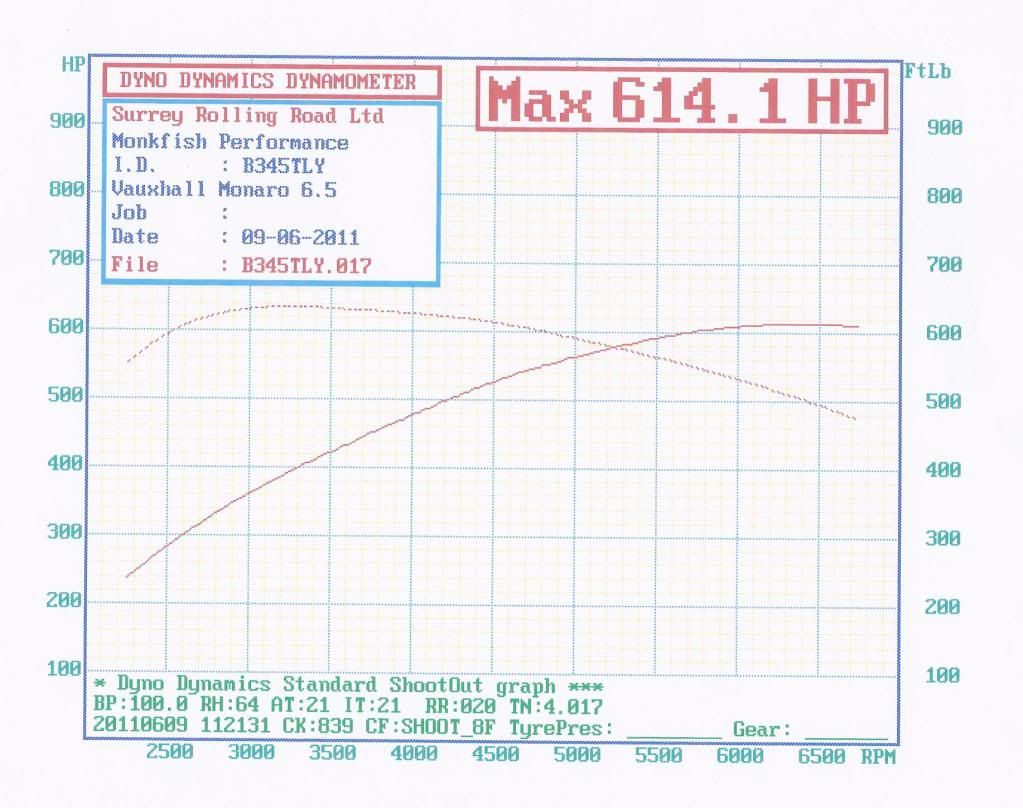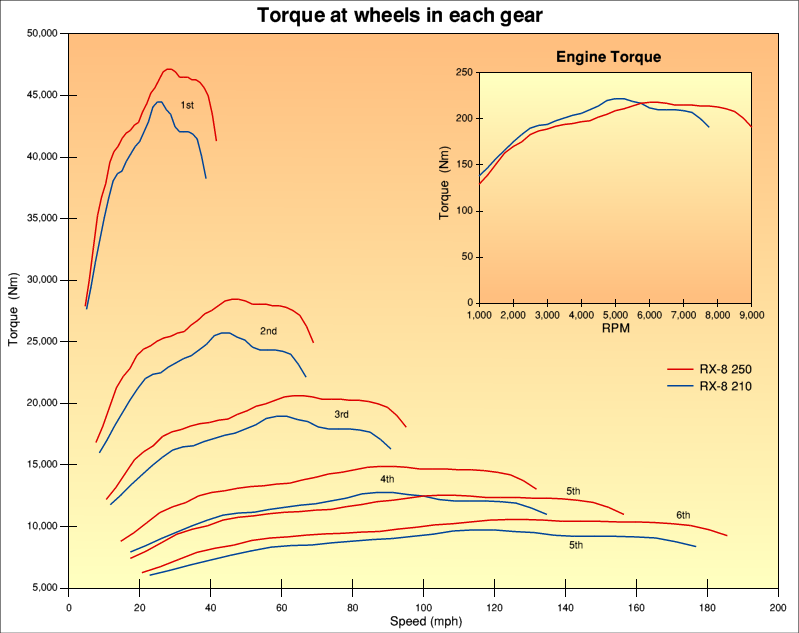Question about BHP + Torque
Discussion
Cerberus90 said:
Pretty sure he means the difference between wheel and fly power when measured on a rolling road.
For example, our TVR produces ~120bhp at the fly, which is about ~96bhp at the wheels.
With 4th gear being 1:1 and diff being 3.89, 120*1*3.89 is obviously not equal to 96.
Torque at the wheels is torque at the fly multiplied by the gear ratio(s). The rpm is divided by the same ratio so the power's the same, less losses of course.For example, our TVR produces ~120bhp at the fly, which is about ~96bhp at the wheels.
With 4th gear being 1:1 and diff being 3.89, 120*1*3.89 is obviously not equal to 96.
wedgeinald said:
This is VERY simplistic but here goes...
Torque is the ability to accelerate
Power is the ability to maintain speed
Yes its more complex than that as the two are related.
You can have a high torque figure at low revs and that car will accelerate from much lower speeds.
If you have low torque at high revs, you can still have more power than at the lower revs, but less ability to accelerate.
I hope this is of some help.....
So a high torque car is the best for accelerating all else being equal. But why do say an M3 which has less acceleration torque than a high torque diesel accelerate much faster?Torque is the ability to accelerate
Power is the ability to maintain speed
Yes its more complex than that as the two are related.
You can have a high torque figure at low revs and that car will accelerate from much lower speeds.
If you have low torque at high revs, you can still have more power than at the lower revs, but less ability to accelerate.
I hope this is of some help.....
Speedy11 said:
Cerberus90 said:
Pretty sure he means the difference between wheel and fly power when measured on a rolling road.
For example, our TVR produces ~120bhp at the fly, which is about ~96bhp at the wheels.
With 4th gear being 1:1 and diff being 3.89, 120*1*3.89 is obviously not equal to 96.
No he defiantly said torque at the wheels not power at the wheels. As power at wheels = power at flywheel - transmission losses.For example, our TVR produces ~120bhp at the fly, which is about ~96bhp at the wheels.
With 4th gear being 1:1 and diff being 3.89, 120*1*3.89 is obviously not equal to 96.
Edited by Speedy11 on Monday 28th July 20:50
HP & TQ at wheels:

Flywheel HP on a different day:

Edited by anonymous-user on Monday 28th July 21:30
Welshbeef said:
So a high torque car is the best for accelerating all else being equal. But why do say an M3 which has less acceleration torque than a high torque diesel accelerate much faster?
Because acceleration is to do with torque at the wheels which is why you accelerate best in 1st and slowest in top. Having more RPM's allows you to have a higher ratio so even though you have less engine torque you have more wheel torque or having more RPM's allows you to stay in a lower gear.For example
M3 E92 Coupe manual
1st 4.06
2nd 2.4
3rd 1.58
4th 1.19
5th 1.00
6th 0.87
Diff 3.85
Rev Limit 8000
Torque 295 lb·ft
335d E90 Sedan automatic
1st 4.17
2nd 2.34
3rd 1.52
4th 1.14
5th 0.87
6th 0.69
Diff 2.81
Rev Limit 5000
Torque 428 lb·ft
Ignoring the shape of the torque curve.
In 1st the M3 torque at wheels = 4.06*3.85*295 =4600
335d = 428*4.17*2.81=5015
However because the M3 can go to 8000rpm, in 1st the Max wheel RPM would be 8000/(4.06*3.85) = 511RPM the 335d however 5000/(4.17*2.81) = 425RPM so the M3 will still be in 1st while the 335d will be in 2nd
So simply put even though the 335d produces more torque at the wheels for each gear the M3 can hold onto a lower gear so producing more torque at the wheels at a given road speed.
Welshbeef said:
wedgeinald said:
This is VERY simplistic but here goes...
Torque is the ability to accelerate
Power is the ability to maintain speed
Yes its more complex than that as the two are related.
You can have a high torque figure at low revs and that car will accelerate from much lower speeds.
If you have low torque at high revs, you can still have more power than at the lower revs, but less ability to accelerate.
I hope this is of some help.....
So a high torque car is the best for accelerating all else being equal. But why do say an M3 which has less acceleration torque than a high torque diesel accelerate much faster?Torque is the ability to accelerate
Power is the ability to maintain speed
Yes its more complex than that as the two are related.
You can have a high torque figure at low revs and that car will accelerate from much lower speeds.
If you have low torque at high revs, you can still have more power than at the lower revs, but less ability to accelerate.
I hope this is of some help.....
Because I (deliberately) over simplified?
The Diesel produces the Torque at lower revs so there is less Power behind the Torque.
If you have two engines with the same Torque figure but one produces it at higher revs, then that one will (obviously?) accelerate better at that point in the rev range.
Given the same gearing the car with the torque at lower revs could accelerate better at lower speeds, but in theory would be beaten by the car with the higher power later in the rev range. The two are linked so its not as simple as my example makes out, it was just to (hopefully) make it easier to visualise.
Diesels tend to be geared MUCH higher to allow for the lower revs at which the torque/power are produced.
Hopefully I haven't confused it more again now?
Speedy11 said:
Explain what? You don't know what or how torque works? Or a gearbox?
Are you being obtuse or do you not know how a rolling road dyno works? It measures torque and rpm AT THE WHEELS and calculates power. It also calculates flywheel figures based on what it thinks the drive train losses are. These are based on how long the rollers take to decellerate.
Flywheel figures (unless the engine is on an engine dyno as mine has been) are the preserve for people with not very powerful motors to make them sound more powerful than they are.
Edited by anonymous-user on Monday 28th July 22:12
wormus said:
Are you being obtuse or do you not know how a rolling road dyno works?
It measures torque and rpm AT THE WHEELS and calculates power. It also calculates flywheel figures based on what it thinks the drive train losses are. These are based on how long the rollers take to decellerate.
Flywheel figures (unless the engine is on an engine dyno as mine has been) are the preserve for people with not very powerful motors to make them sound more powerful than they are.
It measures torque at the wheels, but the graph you posted isn't torque at the wheels. You can tell this because it has the RPM of the engine, not the RPM of the wheels across the X axis.It measures torque and rpm AT THE WHEELS and calculates power. It also calculates flywheel figures based on what it thinks the drive train losses are. These are based on how long the rollers take to decellerate.
Flywheel figures (unless the engine is on an engine dyno as mine has been) are the preserve for people with not very powerful motors to make them sound more powerful than they are.
Edited by wormus on Monday 28th July 22:12
Welshbeef said:
wedgeinald said:
This is VERY simplistic but here goes...
Torque is the ability to accelerate
Power is the ability to maintain speed
Yes its more complex than that as the two are related.
You can have a high torque figure at low revs and that car will accelerate from much lower speeds.
If you have low torque at high revs, you can still have more power than at the lower revs, but less ability to accelerate.
I hope this is of some help.....
So a high torque car is the best for accelerating all else being equal. But why do say an M3 which has less acceleration torque than a high torque diesel accelerate much faster?Torque is the ability to accelerate
Power is the ability to maintain speed
Yes its more complex than that as the two are related.
You can have a high torque figure at low revs and that car will accelerate from much lower speeds.
If you have low torque at high revs, you can still have more power than at the lower revs, but less ability to accelerate.
I hope this is of some help.....
Power is power. Power is the overall metric for your car and torque is just a different way of displaying it. They are measuring the same basic thing in different units/metrics.
People need to be taught better at school.
wormus said:
Speedy11 said:
This is what a graph of torque at the wheels should look like

That looks like you are comparing tractive effort pounds to torque ft/lbs
Speedy11 said:
Sorry I know why, but I don't think wormus knows why cars have a gearbox or how one works.
I think we are discussing different things. In the 2 dyno graphs I posted both for my car, one has 800 S_HP (flywheel HP) and 921 ft-lbs. The other shows 614 HP (wheel HP) and 640 ft-lbs. Really not sure where 281 lbs have gone unless one is flywheel TQ and the other is wheel TQ. Both done in 4th gear, same diff, same gearbox and same engine. Really not sure why you are going on about gearboxes.Cerberus90 said:
Speedy11 said:
Then your diff is broken. 4th may be 1, however you still have the diff after the gearbox so 750*1*3.08=2310 lb.ft or 1730 with 25% losses.
Pretty sure he means the difference between wheel and fly power when measured on a rolling road.For example, our TVR produces ~120bhp at the fly, which is about ~96bhp at the wheels.
With 4th gear being 1:1 and diff being 3.89, 120*1*3.89 is obviously not equal to 96.
Gassing Station | General Gassing | Top of Page | What's New | My Stuff


